Best White Label Payment Solutions for MSPs
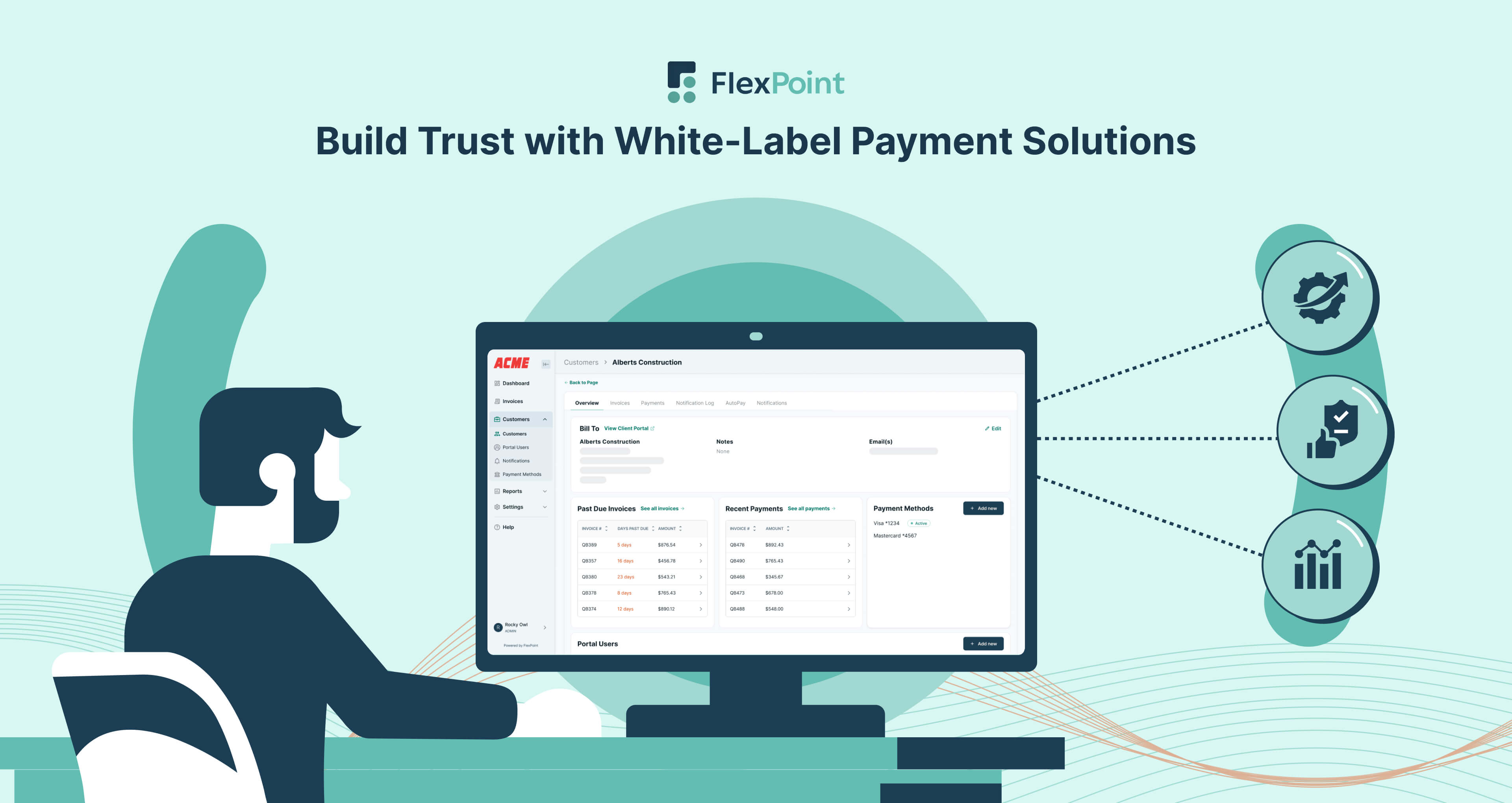
According to Global Growth Insight, the white label payment gateway market size was $2.26 billion in 2024. However, it is projected to grow to $2.7 billion in 2025 and eventually to $4.7 billion in 2033.
This explosive growth reflects the increasing demand from businesses seeking white-label payment solutions that align with their professional identity.
Managed Service Providers (MSPs) face increasing pressure to deliver seamless, professional experiences that match their clients' expectations across every touchpoint.
White-label payment solutions serve as a helpful tool, enabling MSPs to offer a client payment experience on a third-party platform that operates entirely under their brand identity.
These solutions eliminate the need for MSPs to invest substantial time and resources in building complex payment infrastructure from scratch.
It also ensures that every client interaction reinforces their brand rather than directing attention to third-party providers such as PayPal or Stripe.
By maintaining complete brand consistency throughout the client payment experience, MSPs can strengthen trust, reduce confusion, and create a more cohesive service ecosystem.
These white-label payment platforms streamline billing workflows, reduce administrative overhead, and provide clients with intuitive self-service options that enhance satisfaction while freeing up valuable MSP resources for higher-value activities.
In this article, we will examine how white-label payment solutions can enhance MSP billing operations by highlighting key benefits, essential features, and real-world examples of their impact.
{{toc}}
What Is a White Label Payment Solution for MSPs?
White label payment solutions are third-party platforms that enable you to offer fully branded payment processing services without developing the system from scratch.
These platforms handle all the technical work, including a pre-built payment infrastructure, payment processing management, and security and compliance assurance, all while allowing you to customize the user interface to your brand.
For MSPs, this approach simplifies billing operations by eliminating the need to build, maintain, or secure a payment system internally.
Let’s suppose Metro IT Solutions is an MSP managing cloud infrastructure for a mid-sized law firm. When Metro IT sends its monthly $3,500 service invoice, the client receives a professional email that matches Metro IT's branding.
The "Pay Now" button directs the client to a payment portal that resembles Metro's brand, featuring the same logo and custom URL.
The client can choose to pay via their preferred payment method, all within Metro IT's branded environment.
From the client's perspective, they're paying Metro IT Solutions directly through Metro's payment system.
There's no confusion about being redirected to "PaymentProcessor.com" or seeing unfamiliar logos that might raise security concerns. The entire transaction feels like a natural extension of their existing service relationship with Metro IT.
This seamless experience builds trust, reduces payment friction, and reinforces Metro IT's professional brand identity.
Hence, it turns a routine billing interaction into a brand-strengthening touchpoint that differentiates Metro IT from local MSP competitors who rely on generic payment solutions like PayPal or Stripe.
Furthermore, white-label payment solutions ensure compliance with payment-related regulatory standards such as PCI DSS and SAQ-A, thereby reducing your risk and administrative overhead.
This enables the MSP to focus on servicing its clients while delivering a polished and trustworthy client billing experience.
By leveraging a white label payment solution, you can enhance client satisfaction and retention through a streamlined, branded payment and billing experience.
5 Benefits of Using a White Label Payment Platform as an MSP
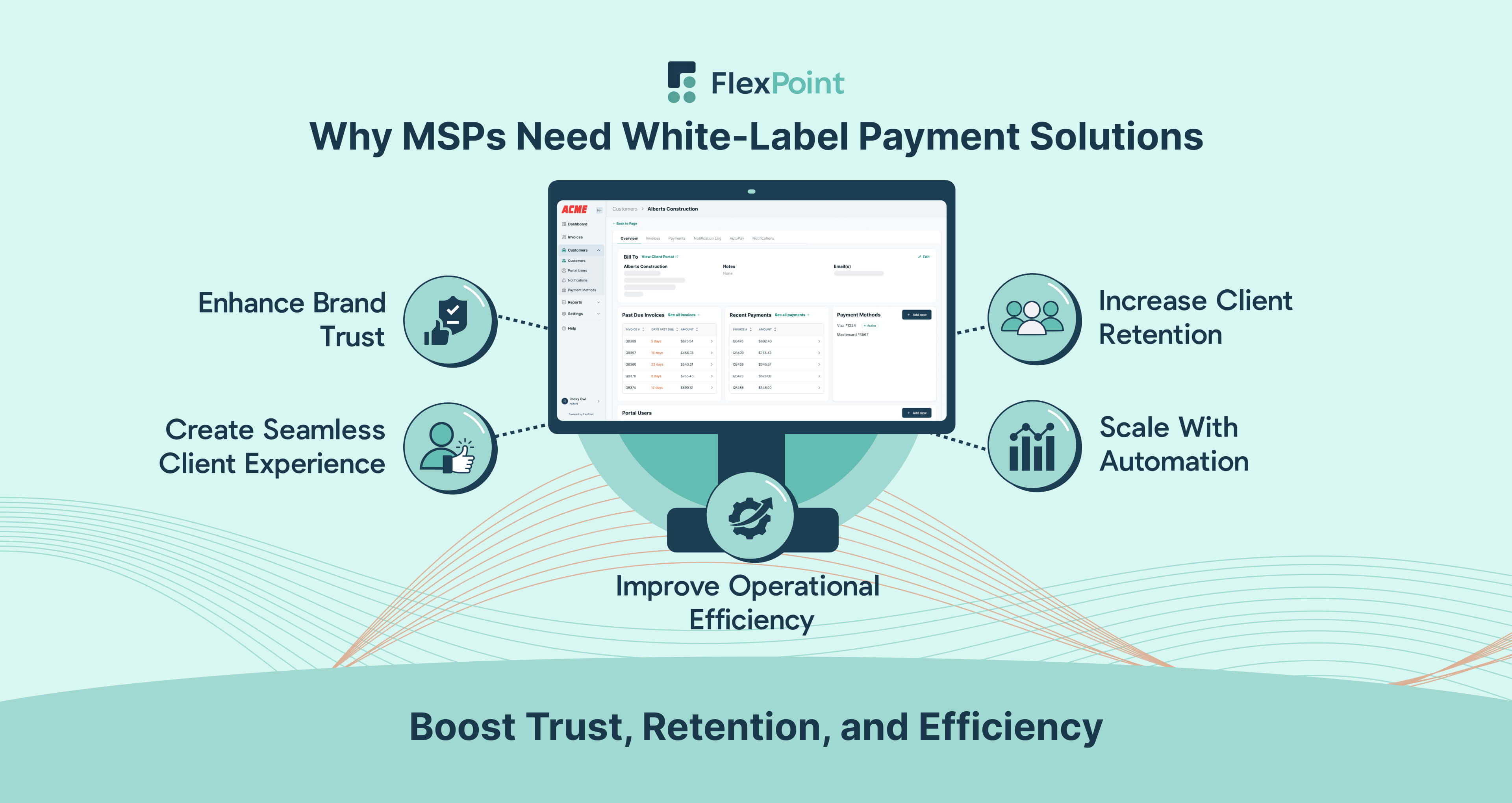
White-label payment platforms offer MSPs measurable business advantages that directly impact payment collection, client satisfaction, and competitive differentiation in an increasingly crowded marketplace.
In this section, we will explain why white-label payment platforms are essential tools for modern MSPs, highlighting both strategic and operational benefits.
1. Enhanced Brand Trust:
When payment portals maintain consistent branding elements, clients perceive the transaction as a natural extension of their existing service relationship rather than an interaction with an unknown third party.
This enhanced trust translates directly into faster payment processing, as it reduces client hesitation during checkout and fewer abandoned payment attempts that can delay cash flow and require additional follow-up efforts.
2. Seamless Client Experience:
White-label platforms eliminate the confusion and brand disconnection that occurs when clients are redirected to generic payment interfaces. Maintaining visual and functional consistency from invoice receipt through payment completion creates a cohesive experience that reinforces their professional brand at every touchpoint.
This seamless flow reduces friction in the payment process, minimizes client questions about payment authenticity, and creates a more polished service delivery experience that clients associate with higher-quality service providers.
3. Operational Efficiency:
A white-label payment solution consolidates all your client payment activities into a single dashboard, eliminating the need to juggle multiple systems or manually track payments. This centralization streamlines your workflows and dramatically reduces administrative overhead, allowing your team to process more payments with less effort and fewer errors.
As a result, your business can handle a higher volume of transactions without needing to increase headcount. Your team is freed up to focus on more valuable work, while your clients benefit from faster, more accurate service. This increased efficiency enables easier scaling of operations and a better overall experience.
4. Client Retention and Differentiation:
Offering a white-label payment solution provides a seamless, branded experience for your clients.
By offering a solution that looks and feels unique to your business, you set yourself apart from competitors who rely on off-the-shelf or unbranded tools. Clients are more likely to stay with a provider that makes their lives easier and offers a tailor-made service. This helps you retain clients longer and positions your business as a modern, client-focused partner.
5. Scalability and Automation:
A white-label payment solution gives your business the tools to automate routine payment tasks – like invoicing, reminders, and reconciliation – so your team doesn’t have to handle everything manually. Automated workflows reduce the risk of human error and ensure payments are processed quickly and accurately, even as your client base grows.
As automation takes over repetitive tasks, your business can scale up easily without overwhelming your staff or compromising service quality. You can onboard new clients faster and handle increasing transaction volumes smoothly, allowing your team to focus on higher-value activities and strategic growth.
Beyond the branding, a white-label payment platform has a direct impact on critical business outcomes, including cash flow, client retention, and brand strength.
It doesn’t just look professional; it builds trust by providing clients with a seamless, familiar experience from invoice to payment.
This clarity and consistency reduce hesitation and billing disputes, leading to faster collections and fewer missed payments.
At the same time, the branded experience reinforces the MSP’s identity, making every billing interaction an extension of their service quality.
8 Key Features to Look for in a White Label Payment Solution
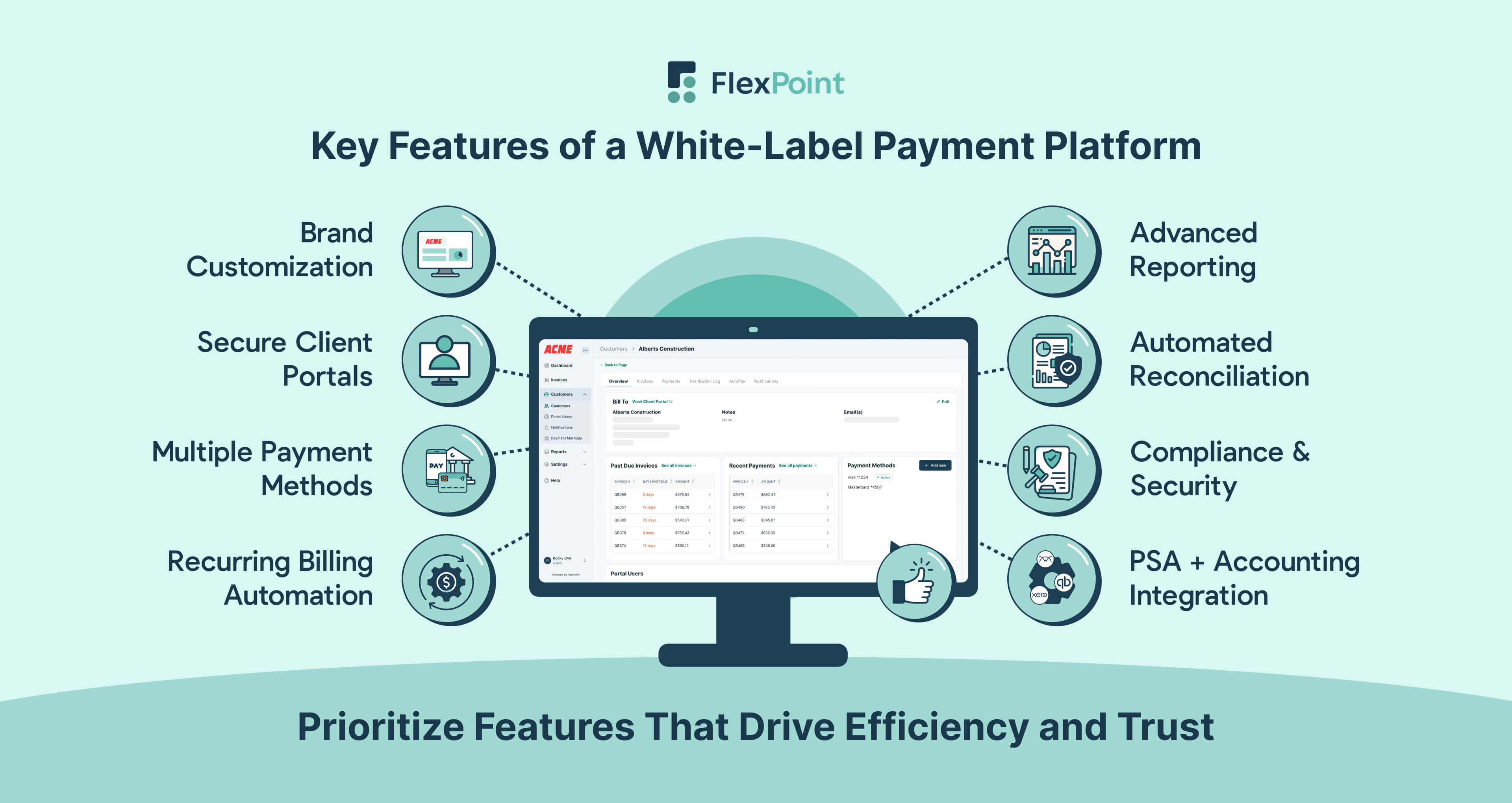
This section explains how MSPs can assess various white-label payment platforms by highlighting the key features they should prioritize to ensure long-term value and operational compatibility.
It guides readers in identifying platforms that offer seamless branding customization, robust automation for invoicing and payment collection, real-time payment tracking, and integrations with key tools, such as PSA and accounting software.
Here are the essential features to prioritize:
1. Brand Customization:
When evaluating white-label payment platforms, prioritize features that support brand credibility.
Look for robust brand customization options, such as using your logo and domain, to ensure a seamless client experience that reinforces your identity.
2. Client Payment Portals:
You should also prioritize solutions that offer secure, user-friendly client portals, allowing clients to easily log in, view invoices, and make payments.
To reduce administrative workload, look for platforms that support full branding customization to maintain a consistent client experience, along with automated invoicing, recurring billing, and real-time payment tracking.
3. Multiple Payment Methods:
When considering white-label payment platforms, look for platforms that support multiple payment methods, including ACH, credit cards, and installment plans/flexible financing, to provide clients with flexibility while optimizing transaction costs.
4. Recurring Billing and Automation:
When selecting white-label payment platforms, look for robust recurring billing capabilities that allow you to schedule invoices automatically, which is ideal for monthly service agreements.
Additionally, these platforms can automate follow-up reminders to ensure timely payments and reduce late payments.
5. Advanced Reporting:
Look for platforms that have dashboards, which display payment status, outstanding invoices, cash flow trends, and aging receivables, enabling you to make informed business decisions quickly.
The ideal solution should also provide detailed analytics on payment patterns, client payment history, and revenue forecasting, while offering customizable reports that can be branded and shared with stakeholders.
6. Automated Reconciliation:
Your ideal solution should automatically sync payment data between the payment portal and existing accounting systems (such as QuickBooks Online, QuickBooks Desktop, Xero), thus eliminating manual data entry, duplication, and reducing the risk of errors.
Look for platforms that can match payments to invoices in real-time, automatically update account balances, and generate reconciliation reports that clearly display all financial transactions.
7. Compliance & Security:
Given the sensitive financial and client data MSPs handle, strong security and compliance features are non-negotiable. The platform must comply with industry standards, such as the PCI DSS (Payment Card Industry Data Security Standard) and SAQ-A compliance requirements.
Additionally, look for security features such as end-to-end encryption, tokenization, multi-factor authentication (MFA), and fraud detection. These measures protect client data, prevent breaches, and reduce the risk of penalties or reputational damage.
8. Seamless PSA and Accounting Software Integration:
Integration with Professional Services Automation (PSA) tools (such as ConnectWise, Autotask, HaloPSA, SuperOps) and accounting systems is crucial. This integration ensures a seamless data flow between systems, eliminating the need for manual data entry, reducing billing errors, and streamlining workflows. It gives you a unified view of billing, service management, and financial data, enabling more accurate reporting and informed decision-making.
Choosing a white-label payment platform is a long-term investment that has a significant impact on your financial health and operational efficiency.
The right platform should simplify today’s billing tasks and scale effortlessly as the client base expands and operations become more complex.
Investing in a system that offers reliable automation, seamless integrations, and a strong client-facing experience ensures that billing won’t become a bottleneck as the business grows.
By prioritizing future-ready tools, you can save time, reduce overhead, and focus on delivering high-value services to your clients.
Top White Label Payment Solution Options for MSPs
This section highlights several white-label payment solutions that MSPs may consider, each with its own strengths and limitations.
While many white-label payment solutions are available on the market, few are truly optimized for the specific needs of MSPs.
Most platforms focus on general business use or software providers, lacking key features like PSA integrations, service-based billing automation, and tools for streamlined client communication.
As a result, MSPs must look beyond surface-level branding and evaluate whether a solution supports their approach to delivering and billing services.
Choosing a platform purpose-built or easily adaptable for MSP workflows can significantly improve efficiency, accuracy, and client satisfaction.
1. FlexPoint
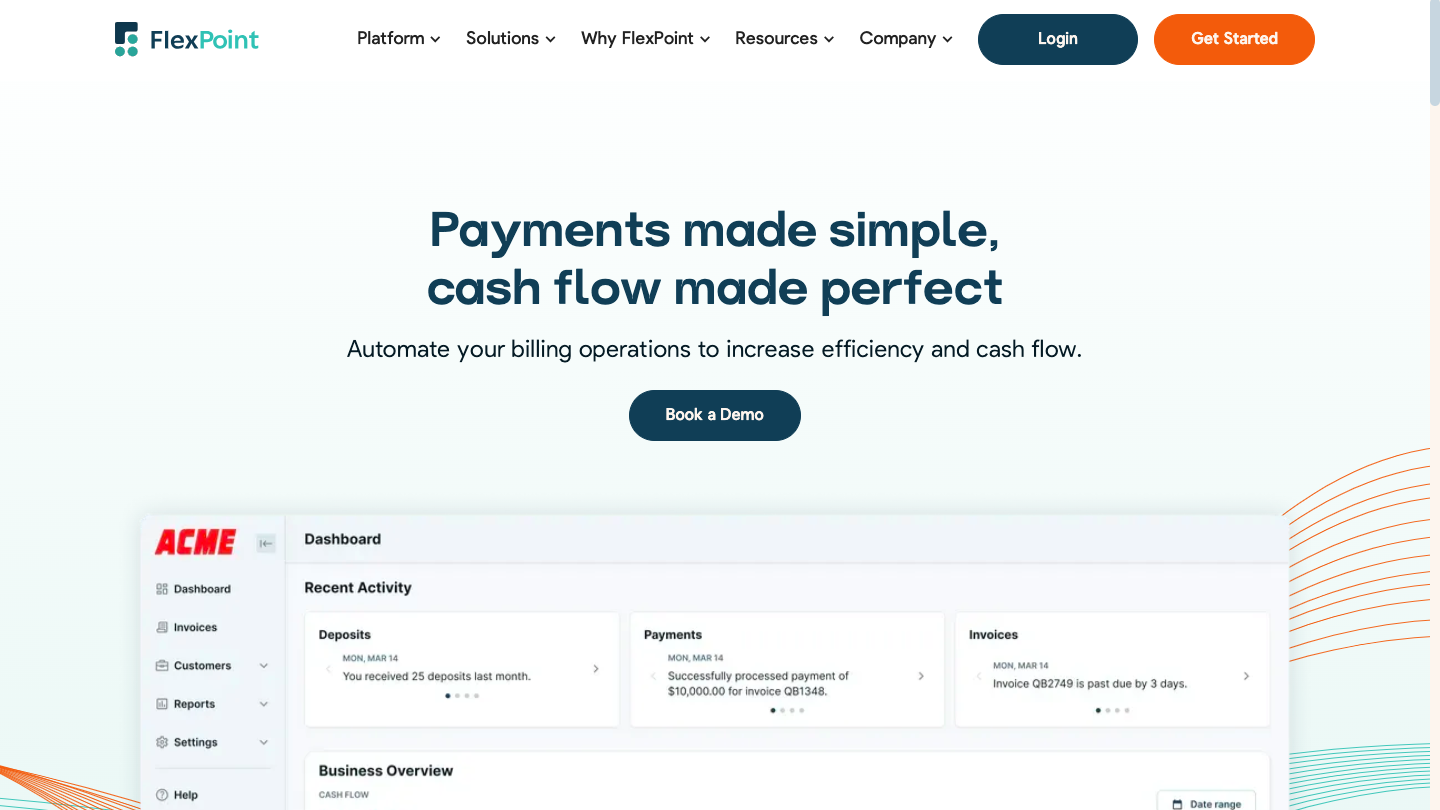
FlexPoint is a payment platform built specifically for MSPs. The platform offers features to streamline financial operations, including full white-label, branded, and customizable client payment portals.
FlexPoint is ideal for: Managed Service Providers (MSPs) of all sizes.
The Pros of Using FlexPoint:
- Built and designed exclusively for MSPs
- Provides a white-label client portal for convenient invoice viewing and payment, which can be fully branded with the MSP's domain and logo.
- Automates invoicing, recurring billing, and reconciliation processes, significantly reducing manual work and errors.
- Offers flexible month-to-month contracts. Competitive pricing.
- Supports multiple payment options, including ACH, credit card, and financing, with features such as AutoPay.
- Credit card surcharging is available (subject to individual state laws).
- PSA software integrations with tools such as ConnectWise, Autotask, SuperOps, and HaloPSA.
- Accounting Software integration with tools such as QuickBooks Online, QuickBooks Desktop, and Xero to ensure automated reconciliation.
The Cons of Using FlexPoint:
- Currently, it has limited integrations, though it is rapidly expanding.
2. Stripe (via API)
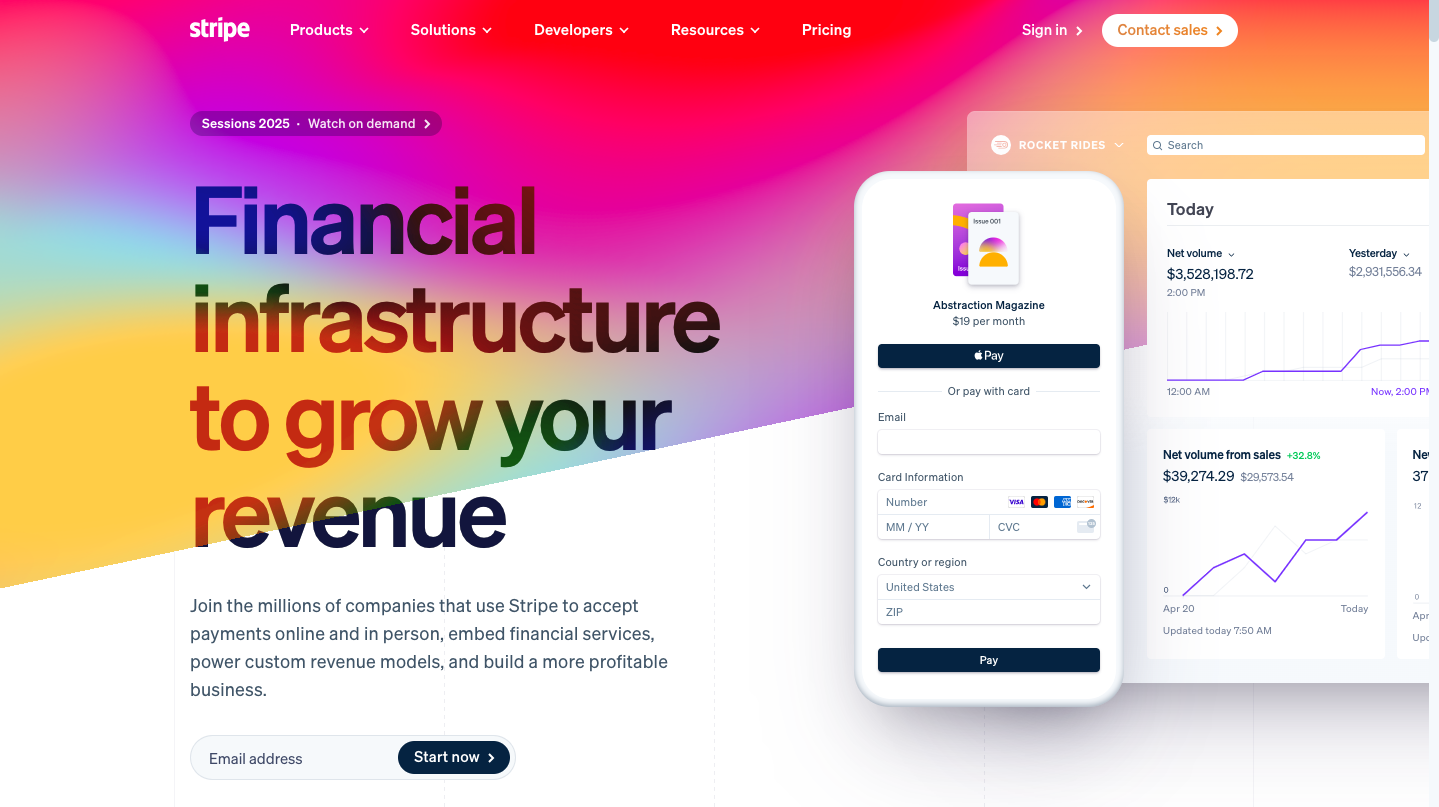
Stripe is a powerful payment platform that gives MSPs complete control over building a custom, branded billing system using its APIs.
However, Stripe is a general-purpose payment solution, not specifically designed for MSP operations.
It lacks built-in features essential for MSPs, such as service agreement management tools or direct PSA integrations, meaning you must develop and maintain these critical functionalities yourself.
Stripe is ideal for: developers, software companies, and tech-focused businesses who need a flexible, programmable payment solution.
The Pros of Using Stripe:
- Highly customizable through APIs, offering flexibility for developers.
- Robust infrastructure for various payment methods and global transactions.
- Advanced machine learning algorithms for real-time fraud detection.
- No long-term contracts.
The Cons of Using Stripe:
- Stripe requires technical expertise and developer resources for integration and customization, making it a non-turnkey solution for MSPs.
- Higher credit card processing rates. A flat-rate pricing model can become expensive for high transaction volumes.
- Does not offer ACH (Same-day ACH) or installment plans.
- Not specifically built for MSP workflows or deep PSA integrations.
- Limited direct client self-service functionalities tailored to MSP needs.
3. Stax
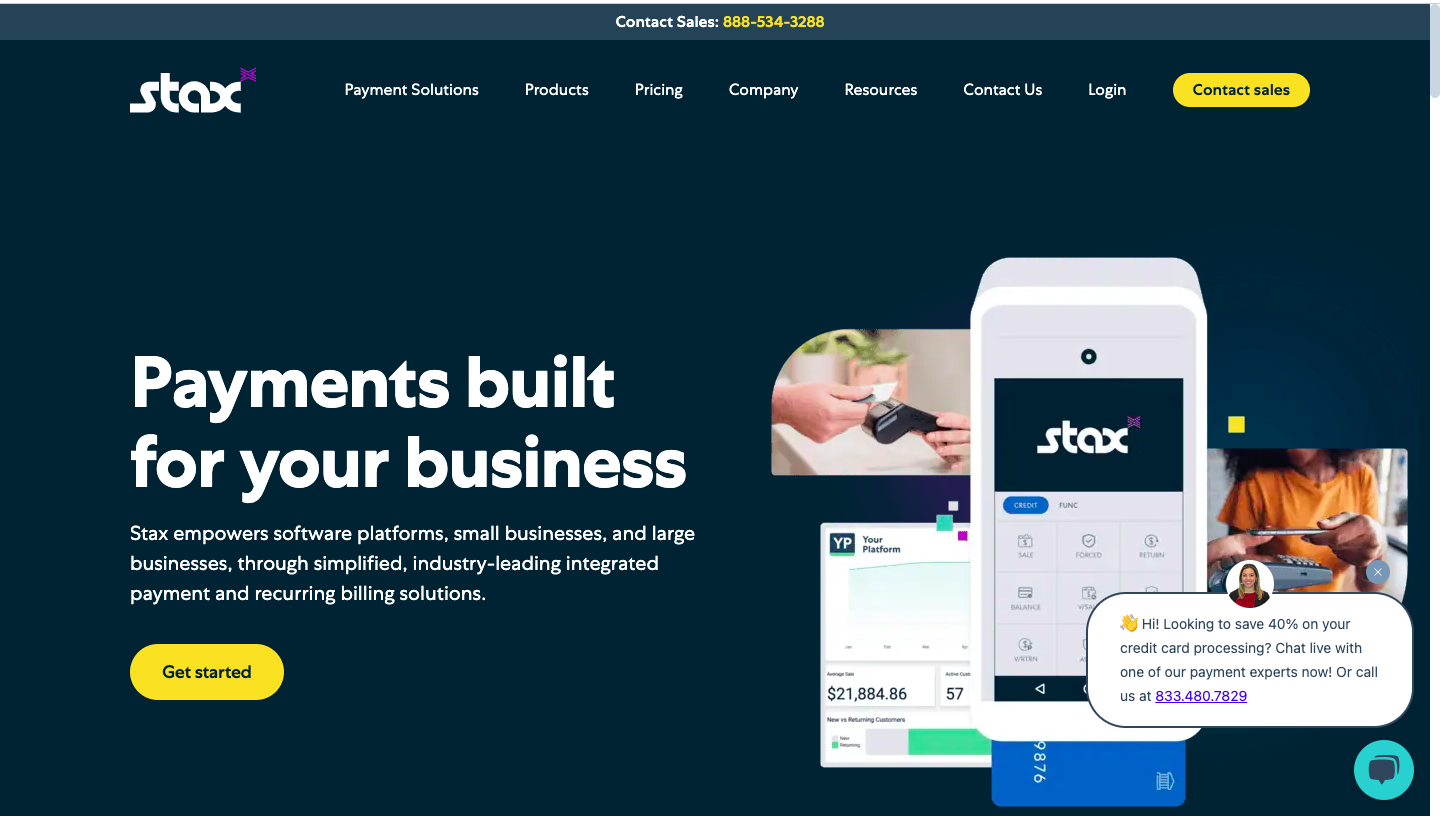
Stax offers payment solutions for small and mid-sized businesses, with some white-label capabilities for partners. It provides tools for invoicing, payment processing, and reporting through a user-friendly platform.
While it's easy to set up and manage, it's not specifically designed for MSPs. It lacks built-in integrations with PSA tools or automation for service-based billing.
Stax is ideal for: Small to medium businesses (SMBs) across various industries that seek simplified payment processing, and resellers are interested in white-label solutions.
The Pros of Using Stax:
- Flat-rate subscription pricing can lead to cost savings for high-volume processors.
- Offers multiple payment options and tools for invoicing and recurring billing.
- Provides a white-label program for partners and resellers.
The Cons of Using Stax:
- Lacks MSP-specific automation and workflows.
- Does not offer flexible financing or installment plans.
- Does not offer native or deep integrations with MSP-specific PSA tools.
- The white-label programme may be more suited for payment resellers than direct MSPs.
Why FlexPoint’s Branded Client Portal Is the Best Fit for MSPs
Unlike generic tools, FlexPoint was built from the ground up to support the unique billing workflows of MSPs. This makes it the perfect fit for modern MSP operations.
This section demonstrates how FlexPoint’s branded client portal is the ideal white-label payment solution for MSPs. It offers a seamless, professional experience that fully reflects your brand.
1. Custom Branding:
Using FlexPoint's brandable client portal, you can ensure that everything your clients see (including your logo) reflects your brand, not that of a third-party provider. This builds trust and reinforces your identity at every client touchpoint.
Additionally, FlexPoint provides a seamless, branded payment experience that aligns perfectly with your operational needs. This makes FlexPoint the ideal white label payment solution tailored to the MSP business model.
2. Self-Service Client Portals:
The FlexPoint client portal is ideally designed to serve as a self-service portal for clients. This means your clients can log in at any time to view invoices (both past and current), set up bank accounts and cards for AutoPay, and choose from multiple payment methods.
This eliminates the need for back-and-forth emails, giving clients more control and convenience. As a result, it ensures a seamless white label payment experience that strengthens client relationships and streamlines your billing operations.
3. Automated Reminders:
FlexPoint customizable portal features an automated payment reminder system that manages all client communications under the MSP's brand. It sends pre-due alerts, due date reminders, and past-due follow-ups without any manual intervention while maintaining professional client relationships.
This MSP-specific design, paired with real-time data synchronization and comprehensive automation capabilities, positions FlexPoint as the ideal solution for MSPs who want to streamline their payment workflows while delivering superior client experiences.
4. Automated Reconciliation:
MSPs can utilize FlexPoint's branded portal to automatically match payments with invoices, update accounting records, and maintain accurate financial reporting across all connected platforms.
This MSP-focused reconciliation capability eliminates the tedious manual processes that consume valuable administrative time. It lets you maintain accurate books while presenting your clients with a branded payment experience.
5. Built-In Credit Card Surcharging Option:
FlexPoint enables you to automatically pass on credit card processing fees to clients, where permitted by state laws, without disrupting the client experience.
This surcharging is seamlessly integrated into the branded client portal, ensuring the entire process remains professional and consistent with the brand. FlexPoint ensures compliance with local regulations, eliminating the guesswork and risk.
6. Compliance:
FlexPoint helps you maintain compliance with critical regulations such as PCI DSS (Payment Card Industry Data Security Standard) and SAQ-A. It removes the burden of managing complex security requirements that can overwhelm service providers.
FlexPoint handles all compliance responsibilities behind the scenes. This ensures you offer secure payment processing through their branded portal without worrying about certification maintenance, security audits, or regulatory updates.
7. Client Trust & Experience:
When clients log in to pay invoices or review billing details, they see your logo and custom domain, with no third-party branding to create doubt or confusion. This consistency strengthens trust, reduces friction during the payment process, and leads to faster payments.
Unlike generic payment tools, FlexPoint was explicitly designed for MSP billing operations, featuring recurring agreement support and PSA integration features. This makes it the ideal white-label solution to enhance client experience and operational efficiency.
FlexPoint provides an all-in-one, fully branded client experience explicitly designed for modern MSPs.
Everything happens within a sleek and professional portal that reflects your brand, from invoice delivery to payment collection. You don’t need to stitch together third-party platforms or customize off-the-shelf solutions.
With FlexPoint, you get a purpose-built billing engine and a white-labeled client interface in one seamless package.
Conclusion: Strengthen Client Trust with a Branded Payment Experience
White-label payment solutions are a wise investment for MSPs seeking to deliver a seamless, professional payment experience under their brand.
With a branded billing experience, MSPs build greater trust with clients, who are more likely to view the provider as polished, professional, and reliable.
Internally, these tools streamline billing workflows by automating invoicing, payment collection, and reconciliation processes, freeing up valuable time and reducing costly errors.
And with consistent branding across every billing touchpoint, MSPs reinforce their identity and professionalism with every transaction.
For MSPs seeking more than a generic payment tool, it’s worth evaluating FlexPoint, a platform designed specifically to support MSP operations.
Unlike general solutions, FlexPoint offers a fully branded client portal, deep integrations with PSA and accounting software, and automation features tailored to service-based billing.
The platform streamlines collections, minimizes manual effort, and provides clients with a smoother, more professional experience.
If your goal is to streamline payments while focusing on delivering excellent service, FlexPoint is designed with your MSP business in mind.
By consolidating these functions into an all-in-one branded experience, FlexPoint helps modern MSPs streamline operations, enhance client satisfaction, and boost profitability.
Looking to deliver a seamless branded payment experience for your clients?
Schedule a demo to see how FlexPoint powers branded billing for modern MSPs.
Additional FAQs: White Label Payment Solutions for MSPs
{{faq-section}}




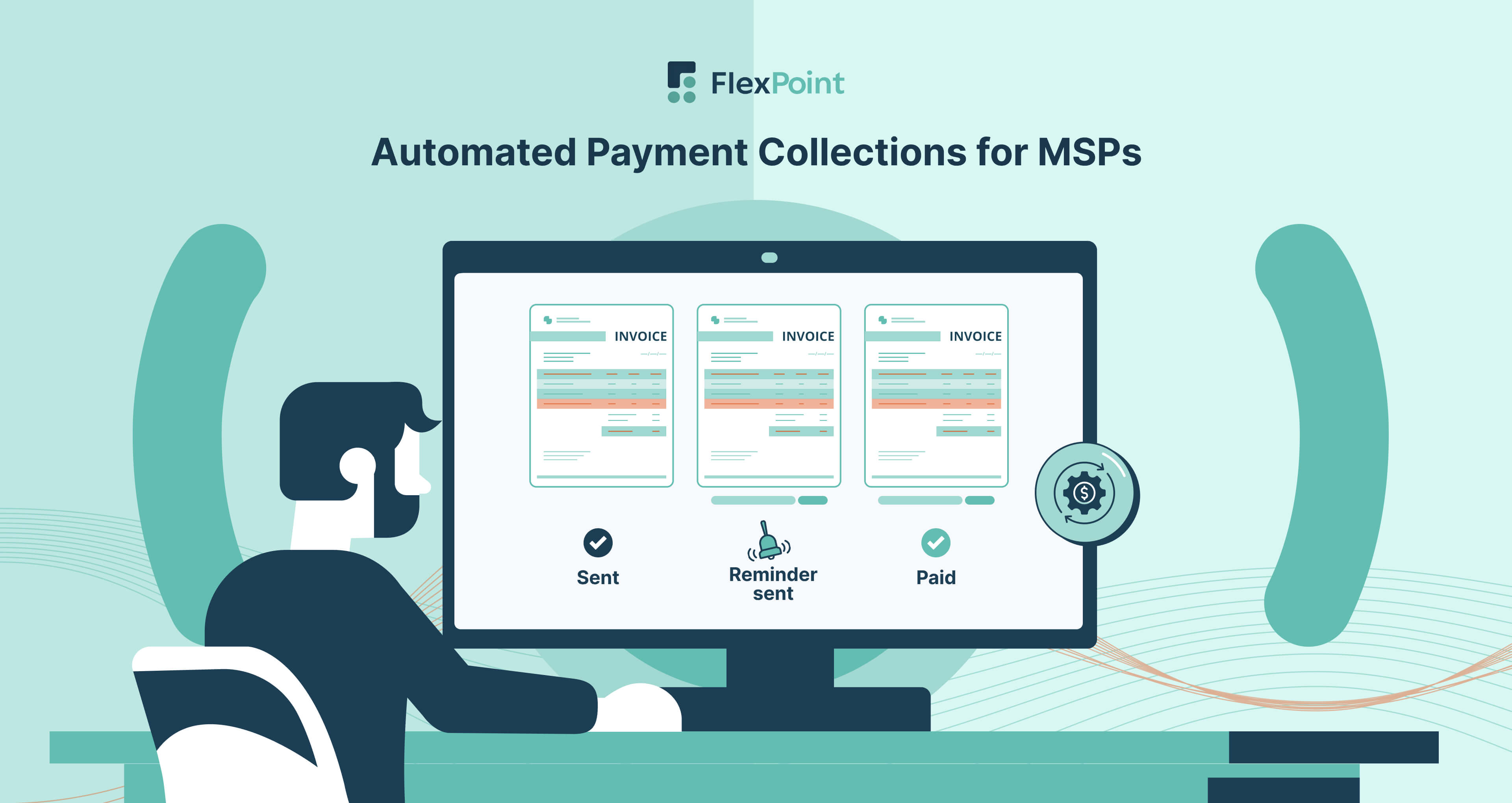

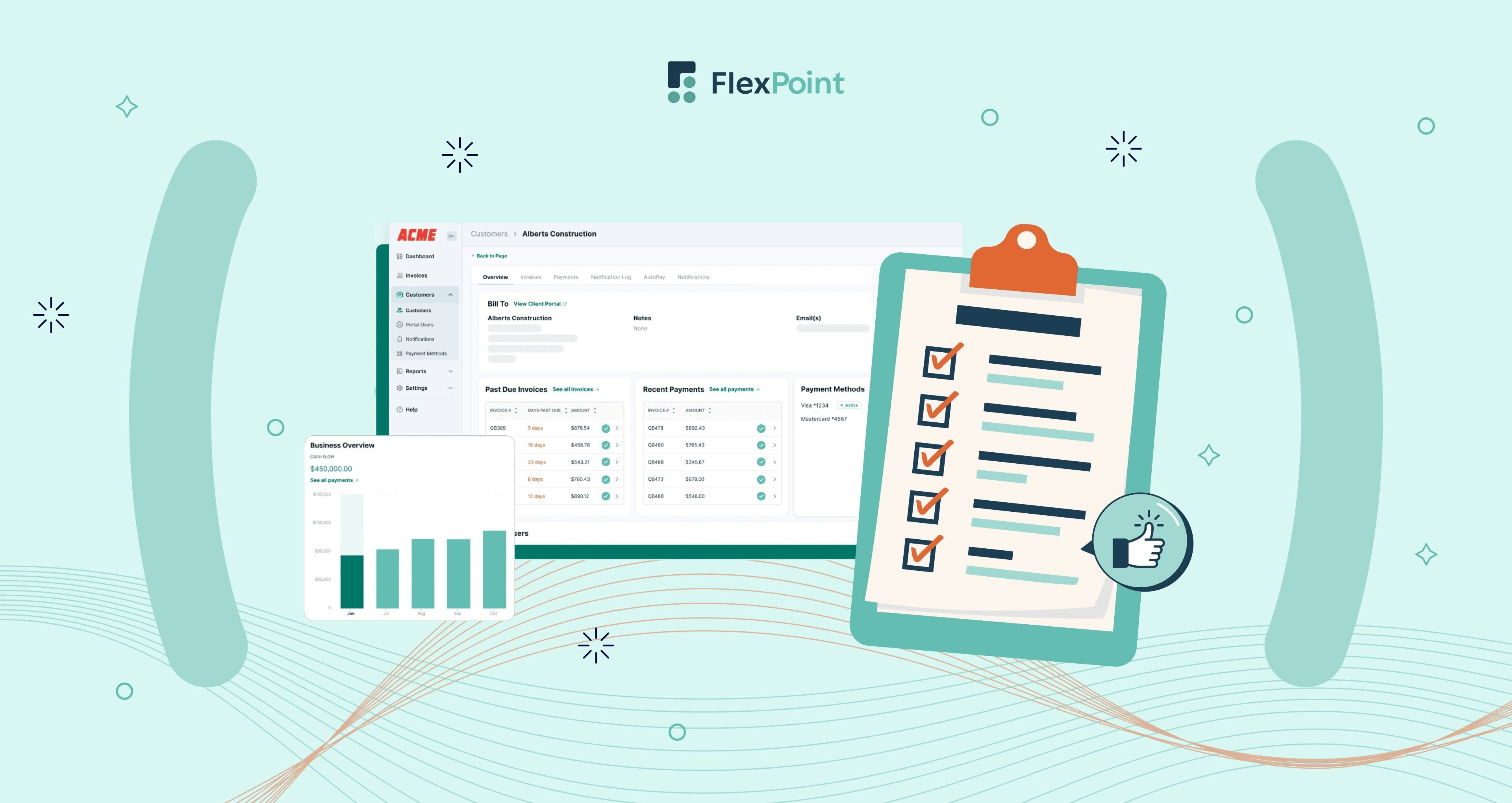


.avif)